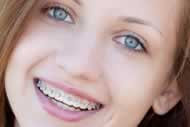Orthodontic Appliances
Orthodontic appliances, make caring for your teeth and gums more challenging. Orthodontic appliances get in the way of your toothbrush, and they make flossing difficult. And food can become lodged in the appliance, which is unsightly and bad for your teeth.
Preventing buildup of plaque and removing extra food particles are important to maintaining good oral health when you have an orthodontic appliance.



Brushing Your Teeth and Flossing Orthodontic Appliances
To remove plaque, you should brush around all parts of your orthodontic appliance and all of the surfaces of your teeth. Ideally, you should brush after every meal or snack. If you can’t brush right away, rinse your mouth well with water.
A manual toothbrush works well if you use it correctly. But when you have an orthodontic appliance in your mouth, you may find it easier to use a power toothbrush like the one included with the Waterpik Complete Care. Watch your toothbrush head for wear. Due to the orthodontic hardware in your mouth, you will need to replace the brush head more often.
You also need to floss to remove the plaque that your toothbrush cannot reach. A floss threader is one method for flossing with orthodontic appliances, but it can be difficult and time consuming.
Make Flossing Easier
One easy and effective way to remove plaque and improve gum health around orthodontic appliances is to use the Orthodontic Tip with the Waterpik Water Flosser.
The Orthodontic Tip is designed with a tapered brush on the end to help remove plaque that sticks to appliance parts and between your teeth. It also helps flush out the bacteria and food debris from around teeth and under the gums.
Will using a Waterpik damage my braces?
A Waterpik should not damage your braces if used correctly.
In fact, it can be a very effective tool for cleaning around braces and wires, helping to remove food particles and plaque that can get stuck in hard-to-reach areas. However, it is important to use your Waterpik correctly to avoid any damage to your braces.
Here are a few things to keep in mind:
- Use the orthodontic tip: When using a Waterpik with braces, it is important to use an orthodontic tip that is specifically designed to clean around brackets and wires. This tip is gentler and less likely to damage your braces.
- Use the right pressure: Be sure to start with the lowest pressure setting and gradually increase the pressure as you get more comfortable. Avoid using high pressure, as it can damage your braces or cause discomfort.
- Aim at the correct angle: When using your Waterpik, aim the tip directly at the gum line, holding it at a 90-degree angle to the tooth surface. This will help avoid damage to your braces.
- Be gentle: When cleaning around your braces, be gentle and take your time. Do not force the water into tight spaces, as this can cause damage.
- Clean your Waterpik regularly: To avoid bacteria build-up, clean your Waterpik regularly according to the manufacturer's instructions.
Overall, a Waterpik can be a safe and effective tool for cleaning around braces if used correctly. If you have any concerns or questions, be sure to consult with your orthodontist or dentist for additional guidance.
Other advice for orthodontic appliance care
Using fluoridated toothpaste or adding a fluoride rinse to your routine can help prevent decay. It's also important to continue your regular dental check-ups during orthodontic treatment.

